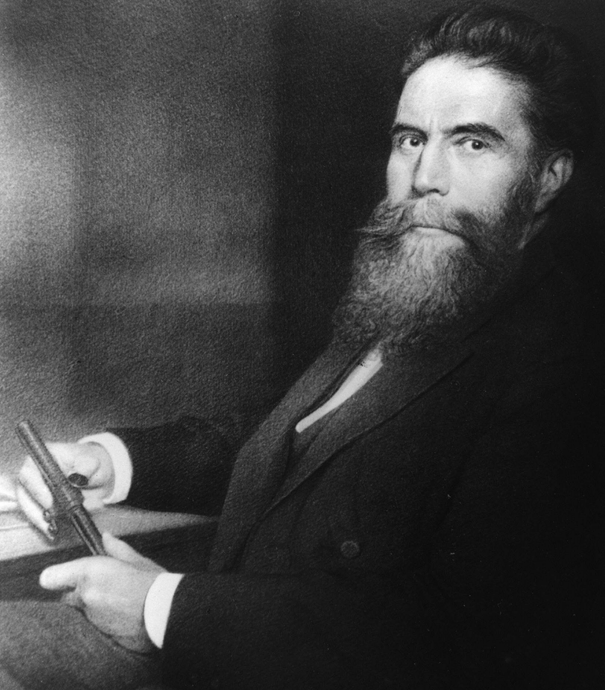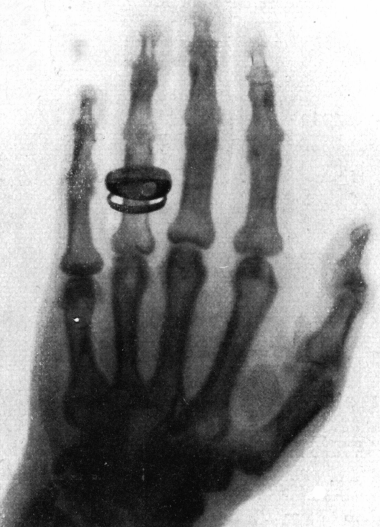X-rays were accidentally discovered in 1895 by Wilhelm Roentgen, a German physicist, who received the first Nobel Prize for the discovery of X-rays, in 1901.

Wilhelm Roentgen
At the age of 50, while doing research at the University of Würzburg, Röntgen accidentally discovered X-rays while working with cathode ray tube. According to Philip Lenard²'s earlier research, he knew that cathode rays could penetrate the aluminum window of the cathode ray tube and cause a fluorescent material to glow on the cardboard behind it, a few centimeters away from the tube.
On November 8, 1895, while conducting his usual experiments with one of the cathode ray tubes in his laboratory, Röntgen covered the tube with a dark cardboard to prevent the light from escaping and reaching the fluorescent screen. The laboratory was dark as well. To his surprise, he saw that the fluorescent screen, which was placed one meter away from the tube, was glowing. He repeated the experiment several times and concluded that something (a ray) was passing through the glass vacuum tube, the cardboard, and the air in the room, and causing the screen to glow. However, he didn't know what it was. After working in this field for seven weeks, he discovered that photographic plates reacted to this type of radiation, but paper and cardboard were transparent to it, and the radiation could easily pass through them.
He demonstrated that these rays, which he later named X-rays, were produced at the point where the cathode rays hit the glass vacuum tube or the aluminum window (the end plate). He explained this phenomenon with the magnetic deflection of cathode rays (beta) to a new location and pointed out that the location where X-rays originated was always aligned with the point of impact of cathode rays on solid materials.
In 1896, Röntgen published a paper and delivered a lecture on his achievements in this field. The image he included in this paper was the image of Albert von Kölliker’s hand.

x-ray image of Rudolf Albert von Kölliker’s hand
Röntgen stated that mass density is a parameter which its changes affect the material's permeability to X-rays. He also proved that the thickness and composition of the material have a significant impact on this matter. He presented a table of thicknesses of metals, including platinum, lead, zinc, and aluminum, which had the same X-ray attenuation. In other words, the same thickness of these materials does not attenuate X-rays to the same degree.
Röntgen noticed that X-rays do not interact with a magnetic field, which indicated that this type of radiation was completely different from cathode rays and must be similar to light, that is, electromagnetic waves. He tested whether X-rays would affect his own eyes, but he did not receive any response. He attempted to measure the thermal effects of X-rays, but was unsuccessful. He also tried to refract X-rays using materials that refract visible light, but did not get any results. He conducted a series of experiments to test reflection and found that regular reflection did not occur, but objects behaved like opaque bodies to X-rays, similar to their behavior towards visible light.
It seems surprising that x-rays had not been discovered before November 8, 1895. Five years before Röntgen's discovery, American Arthur Goodspeed had accidentally produced an x-ray image of some coins and brass weights, but he and his colleague, William Jennings, could not explain the formationof the image and failed to pursue it. . Hundreds of scientists may have observed phenomena by chance and dismissed them. Other scientists, such as Crookes (the inventor of the tube that Röntgen used), also had seen evidence of the existence of X-rays, but attributed them to the low quality of the equipment they used.
Goodspeed later proposed the term radiography for the general application of X-rays, but in Europe, some still refer to this field as "Röntgenology".
In any case, it seems that Röntgen's work was a difficult and valuable one, and it cannot be considered merely a matter of chance, as Philip Lenard suggested.
In 1896, 49 books and over 1,000 technical articles on X-rays were published. Röntgen also published his second paper in 1896 and his third paper in 1897. He received the Nobel Prize in 1901 for the discovery of X-rays.
Reference:
X-ray Imaging (Fundamentals, Industrial Techniques, and Applications) book by Harry E. Martz, Jr.




.jpg)